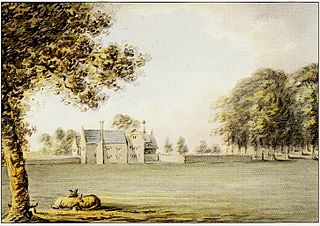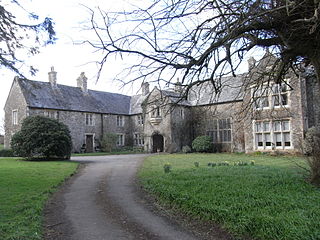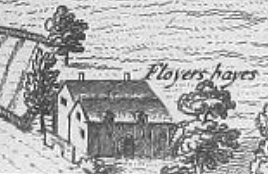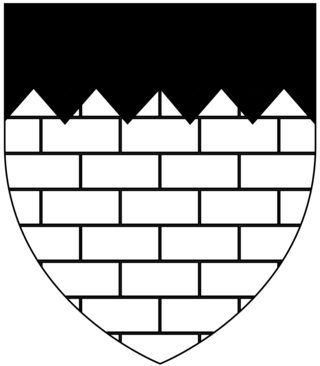
Tamerton Foliot is a village situated in the north of Plymouth, England, that also lends its name to the ecclesiastical parish of the same name.

Brampford Speke is a small village in Devon, 4 miles (6 km) to the north of Exeter. The population is 419. It is located on red sandstone cliffs overlooking the river Exe. Its sister village of Upton Pyne lies to its southwest, and Stoke Canon is across the river, to the east. To the south is the hamlet of Cowley with its chapel of ease, which was formerly part of the ecclesiastical parish of Brampford Speke.

Wonford is a former village, manor and ecclesiastical parish in Devon, England, now a part of the City of Exeter. The 13th century St Loye's Chapel situated within the parish now gives its name to the surrounding location. Wonford is situated next to the former parish of Heavitree, now both covered by the suburbs of Exeter.

Meavy is a small village, civil parish and former manor in the English county of Devon. Meavy forms part of the district of West Devon. It lies a mile or so east of Yelverton. The River Meavy runs near the village. For administrative purposes the parish is grouped with the parishes of Sheepstor and Walkhampton to form Burrator Parish Council, and for electoral purposes it is grouped with the same two parishes to form Burrator Ward.

Countess Wear is a district within the city of Exeter, Devon, England. It lies about two miles south-east of the city centre, on the north bank of the estuary of the River Exe. Historically an estate known as Weare, part of the manor of Topsham, was in this area. From the late 13th century, the construction of weirs in the River Exe by the Countess, and later, the Earls of Devon damaged the prosperity of Exeter to the benefit of Topsham which was downstream of the obstructions, and was owned by the Earls.

Elize Hele (1560–1635) of Fardel in the parish of Cornwood, Devon and of Parke in the parish of Bovey Tracey, Devon, was an English lawyer and philanthropist. In 1632 he transferred his lands into a trust intended for "pious uses", from which charitable action and in order to distinguish him from his many prominent relations, he became known to posterity as "Pious Uses Hele", which his biographer Prince looked upon "as a more honourable appellation than the greatest empty title". The trustees included his wife, together with John Hele and a number of friends. The trust was used to create a number of schools in Devon including Plympton Grammar School.

Cowick is a suburb of the City of Exeter in Devon. Historically it was a manor situated in the parish of St Thomas, Exeter, within the hundred of Wonford. It was formerly the site of a Benedictine monastery.

The estate of Acland in the parish of Landkey, near Barnstaple in North Devon, England, was from 1155 the earliest known seat of the influential and wealthy family of Acland, to which it gave the surname de Acland. It is situated about 3/4 mile north-east of the village of Landkey, from which it is now cut off by the busy A361 North Devon Link Road.

Orleigh is a historic manor in the parish of Buckland Brewer, situated 4 miles to the south west of Bideford, North Devon, England. The manor house is known as Orleigh Court.

Sir John Speke (1442–1518) of Whitelackington, Somerset and of Heywood in the parish of Wembworthy and of Bramford Speke both in Devon, was Sheriff of Devon in 1517 and a Member of Parliament (1477). He was knighted in 1501. His monument is the Speke Chantry in Exeter Cathedral in which survives his recumbent effigy.

Poltimore is a village, civil parish and former manor in the East Devon district, in the county of Devon, England. It lies approximately 5 miles (8.0 km) northeast of Exeter. The parish consisted of 122 households and a population of 297 people during the 2011 census. The parish also includes the hamlet of Ratsloe.

Warleigh is an historic estate within the parish of Bickleigh in Devon, about 6 miles from Plymouth. Warleigh House, the manor house of the manor of Tamerton Foliot is situated one mile west of that village on the south-east bank of the River Tavy where it joins the River Tamar. It was remodelled in about 1830 in the Gothic style by John Foulston and has been listed Grade II* on the National Heritage List for England since 1960.

Nicholas Radford of Upcott in the parish of Cheriton Fitzpaine, and of Poughill, Devon, was a prominent lawyer in the Westcountry who served as Member of Parliament for Lyme Regis, Dorset and Devon (1435). During the anarchic times of the Wars of the Roses he was caught up in the dynastic Westcountry rivalry between Thomas de Courtenay, 5th Earl of Devon, of Tiverton Castle, for whom during his minority he had acted as steward, and William Bonville, 1st Baron Bonville, of Shute. His murder in 1455 by the Earl's faction "ranks among the most notorious crimes of the century", and was the precursor of the Battle of Clyst Heath (1455) fought shortly thereafter near Exeter by the private armies of the two magnates. He served as a Justice of the Peace for Devon (1424-1455), as Escheator for Devon and Cornwall (1435-6), Recorder of Exeter (1442-1455) and as Tax Collector for Devon in 1450 and as Apprentice-at-law for the Duchy of Lancaster (1439-1455).

Floyer Hayes was an historic manor in the parish of St Thomas on the southern side of the City of Exeter in Devon, England, from which city it is separated by the River Exe. It took its name from the ancient family of Floyer which held it until the early 17th century, when it was sold to the Gould family. In the 19th century the estate was divided up and the manor house demolished. The parish church of St Thomas, situated a short distance to the west of the house, was burned down in 1645 during the Civil War, and was rebuilt before 1657. Thus no monuments survive there of early lords of the manor, namely the Floyer family.
The Manor of Bicton is an historic manor in the parish of Bicton in east Devon, England.

Painsford is an historic estate in the parish of Ashprington in Devon.

Walter Reynell of Malston in the parish of Sherford, Devon, was a Member of Parliament for Devon in 1454/55.


















